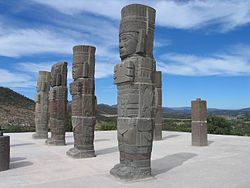Mexico national parks
Mexico's national park system began in 1917 when President Venustiano Carranza elevated the status of Desierto de los Leones to that of Parque Nacional. Today, Mexico recognizes 67 national parks throughout the country. Many are undeveloped areas designated to protect the natural world in its existing state, while some are popular tourist attractions noted for their archaeological or biological significance. Several parks are UNESCO World Heritage sites and several more are UNESCO Biosphere Reserves.
Understand
[edit]Many travelers from around the world visit Mexico's national parks without realizing it. Some of Mexico's most visited national parks include Tulum, Palenque, and Huatulco. Beach lovers who take a day trip to Isla Contoy from the harbors in Cancun are also visiting a national park. So are divers and snorkelers exploring the reefs around Cozumel.


Some of the most spectacular natural scenery in the country is found in the national parks. Parks in Mexico are not often crowded and many provide a refreshing alternative to the often crowded and over-loved parks in the United States.
The national parks showcase Mexico's astounding geographical diversity, demonstrating the rich palette of natural scenery and astounding diversity of plant and animal life. The parks are great places for affordable day trips, physically demanding adventure travel, and contemplative nature watching. Ecosystems represented in Mexico's National Parks include offshore Caribbean reefs, dense coastal swamps and wetlands, rugged mountain peaks, arid deserts, and tropical rain forests and cloud forests.
Mexico's national parks are administered by CONANP (Comision Nacional de Areas Naturales Protegidas). CONANP protects 185 natural areas in Mexico, 67 of which are designated as national parks. Other designations include Reserva Biosfera (Biosphere Reserve), Area de Protecion de Flora y Fauna (protected area for plants and animals), Area de Protecion de Recursos Naturales (protected area for natural resources), Santuario (sanctuary), and Monumento Natural (natural monument).
National parks are the category most likely to appeal to travelers because they are chosen for their scenic beauty and touristic value as well as their scientific value and their need for protection from development or commercial exploitation.
Annual pass
[edit]Mexico's CONANP offers an annual parks pass called Pasaporte de la Conservacion. For an annual fee of M$1736 (about US$75), you can make unlimited visits to Mexico's natural areas, including National Parks and Biosphere Reserves. The pass can be purchased on the CONANP web site.
Parks
[edit]Mexico's national parks include:

- Bahia de Loreto National Park (Baja California Sur)
- Cabo Pulmo National Park (Baja California Sur)
- Constitution 1857 National Park (Baja California)
- San Lorenzo Marine Archipelago National Park (Baja California)
- San Quintin National Park (Baja California)
- Sierra de San Pedro Martir National Park (Baja California)




- Cañón del Rio Blanco National Park (Veracruz_(state))
- Cerro de la Estrella National Park (Mexico City)
- Cofre de Perote National Park (Veracruz_(state))
- Cumbres del Ajusco National Park (Mexico City)
- Desierto del Carmen National Park (Estado de Mexico)
- Desierto del Leones National Park (Mexico City)
- El Chico National Park (Hidalgo)
- El Historico Coyoacan (Mexico City)
- El Tepeyac National Park (Mexico City)
- El Tepozteco National Park (Morelos, Mexico City)
- Fuentes Brotantes de Tlalpan National Park (Mexico City)
- La Marquesa National Park (Estado de Mexico, Mexico City)
- Iztacchuatl-Popocateptl National Park (Estado de Mexico, Puebla)
- La Malinche National Park (Tlaxcala (state), Puebla)
- Lagunas de Zempoala National Park (Morelos, Estado de Mexico)
- Lomas de Padierna (Mexico City)
- Los Marmoles National Park (Hidalgo)
- Los Remedios National Park (Estado de Mexico)
- Molino de Flores Nezahualcoyotl National Park (Estado de Mexico)
- Nevado de Toluca National Park (Estado de Mexico)
- Pico de Orizaba National Park (Veracruz (state))
- Sacromonte National Park (Estado de Mexico)
- Reef System of Veracruz National Park (Veracruz (state))
- Tula National Park (Hidalgo)
- Viveros de Coyoacán National Park (Mexico City)




- Barranca del Cupatitzio National Park (Michoacan)
- Benito Juarez National Park (Oaxaca)
- Bosencheve National Park (Michoacan)
- Cerro de Garnica National Park (Michoacan)
- El Veladero National Park (Guerrero)
- General Juan Alvarez National Park (Guerrero)
- Grutas de Cacahuamilpa National Park (Guerrero)
- Huatulco (Oaxaca)
- Huatulco II National Park (Oaxaca)
- Insurgente Jose Maria Morelos National Park (Michoacan)
- Isla Isabel National Park (Nayarit)
- Islas Marietas National Park (Nayarit)
- Ricardo Flores Magón National Park (Oaxaca)
- Lago de Camecuaro National Park (Michoacan)
- Lagunas de Chacahua National Park (Oaxaca)
- Rayon National Park (Michoacan)
- Uruapan National Park (Michoacan)
- Vicente Guerrero National Park (Guerrero)
- Volcan Nevado de Colima National Park (Colima, Jalisco)
Arrecifes means "reefs" and diving is a popular activity in this region. See Diving in Mexico for details.
- Arrecifes de Alacranes National Park (Yucatan)
- Arrecifes de Cozumel (Quintana Roo)
- Arrecife de Puerto Morelos (Quintana Roo)
- Arrecifes de Xcalak National Park (Quintana Roo)
- Cañón del Sumidero (Sumidero Canyon) (Chiapas)
- Jaguar National Park (Quintana Roo)
- Costa Occidental de Isla Mujeres, Punta Cancun, Punta Nizuc (Quintana Roo)
- Dzibilchantun (Yucatan)
- Isla Contoy (Quintana Roo)
- Lagunas de Montebello National Park (Chiapas)
- Palenque (Chiapas)
- Tulum (Quintana Roo)


 Français
Français Italiano
Italiano



